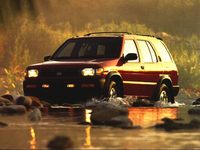SEE ALSO: Nissan Buyer's Guide
New Car/Review
1997 NISSAN PATHFINDER SE-V6 4X4
by Tom Hagin
SPECIFICATIONS
Manufacturer's Suggested Retail Price $ 27,949
Price As Tested $ 31,115
Engine Type 3.3 Liter V6 w/MFI*
Engine Size 200 cid/3275 cc
Horsepower 168 @ 4800 RPM
Torque (lb-ft) 196 @ 2800 RPM
Wheelbase/Width/Length 106.3"/72.4"/178.3"
Transmission Five-speed manual
Curb Weight 4015 Pounds
Fuel Capacity 20.8 gallons
Tires (F/R) P265/70R15
Brakes (F/R) Disc (ABS)/drum (ABS)
Drive Train Front-engine/four-wheel-drive
Vehicle Type Five-passenger/four-door
Domestic Content Five-percent
Coefficient of Drag (Cd.) 0.45
PERFORMANCE
EPA Economy, miles per gallon
city/highway/average 16/18/17
0-60 MPH 11.3 seconds
1/4 Mile (E.T.) 18.3 seconds @ 74.5 mph
Towing capacity 3500 pounds
* Multi-point fuel injection
The lure of sport utility vehicles seems to defy the conventional wisdom. Nearly a million of them are sold each year, and make perfect sense in some locations. In others, they're simply lifestyle statements.
The Nissan Pathfinder was around before sport utility vehicles became popular among people who didn't really need one. The first model was offered in 1987, and enjoyed a nine-year production run without a major remake. In 1996, it was made more civilized for the masses.
OUTSIDE - Last year's redesign abandoned the previous body-on-frame construction for a more car-like unit body layout. Nissan calls it MonoFrame, and says it has over twice the bending stiffness and more torsional rigidity than before. It sits several inches lower than the competition, which makes climbing inside quite easy except for the cramped entry to the rear seats. Our test SE model is the sporty version, and features beefy fender flares, blacked-out bumpers, mirrors and window trim, along with a roof rack, rear spoiler, fog lamps, steel side-steps, and attractive six-spoke alloy wheels. Since it is the off-road representative of the Pathfinder line, we feel the SE version should be offered with larger 16-inch tires - at least as an option.
INSIDE - Pathfinder's interior was made with user-friendliness in mind. The comfortable and supportive front bucket seats are similar to those used in Nissan's Maxima sedan, and are positioned high to give a tall-in-the-saddle feeling. The rear seating is comfortable for two passengers, but crowding three across in back is best left for short jaunts. Hauling cargo is handled by tilting the rear seat's bottom cushion forward, then folding the split seatback forward into the vacated seat well. A 4X8 sheet of plywood can be hauled inside, though it will rest atop the wheel wells and protrude out the tailgate. Standard Pathfinder SE interior features include a 60/40 split rear seat, 160-watt AM/FM/CD player, power windows, antenna, mirrors (also heated) and door locks, cruise control, remote keyless entry, and a rear window wiper/washer.
ON THE ROAD - Pathfinder's 3.3 liter V6 engine uses single overhead camshafts to produce 168 horsepower and 196 lb-ft of torque. It gives good off-the-line acceleration and good power to merge into freeway traffic. Also, over 90 percent of Pathfinder's torque comes on by the time the engine spins to 1500 rpm. This means that Pathfinder drivers need not rev the engine high to get good acceleration, or, in many cases, good pulling power while towing. The optional limited slip rear differential in our test vehicle provides extra traction on slippery roads, or on a great summer day, a slippery boat ramp. Our five-speed manual transmission is the standard Pathfinder gearbox, but we wished our test vehicle had come with the more popular four-speed automatic. Equipped with the automatic, the Pathfinder is rated to tow up to 5000 pound - 1500 pounds more than the stick-shift version.
BEHIND THE WHEEL - Pathfinder underpinnings use an independent front suspension with MacPherson struts and a solid rear axle setup. Both ends ride of soft coil springs and use anti-roll bars to keep the vehicle flat in the corners. The ride is exceptionally smooth on the road, and can handle relatively rough backcountry trails. Body roll in minimal, and the rack-and-pinion steering is nicely weighted. It uses a part-time 4WD system that can be activated up to 50 mph, which comes in handy on alternating patches of snow and ice. All Pathfinder models use front disc and rear drum brakes, with a sophisticated anti-lock braking system (ABS) as standard equipment. This system is designed to lower braking distances on loose dirt or gravel by measuring the amount of "skimming" inherent with conventional ABS systems in action on loose gravel or dirt. We feel however, that four-wheel disc brakes should be offered as either standard or optional equipment, as they were with the 1988 model.
SAFETY - Dual airbags, ABS and side impact beams are standard.
OPTIONS - Its off-road package added black exterior trim, and a limited slip rear differential for $249. The sunroof is a $999 extra, while the automatic climate control is $1199.



